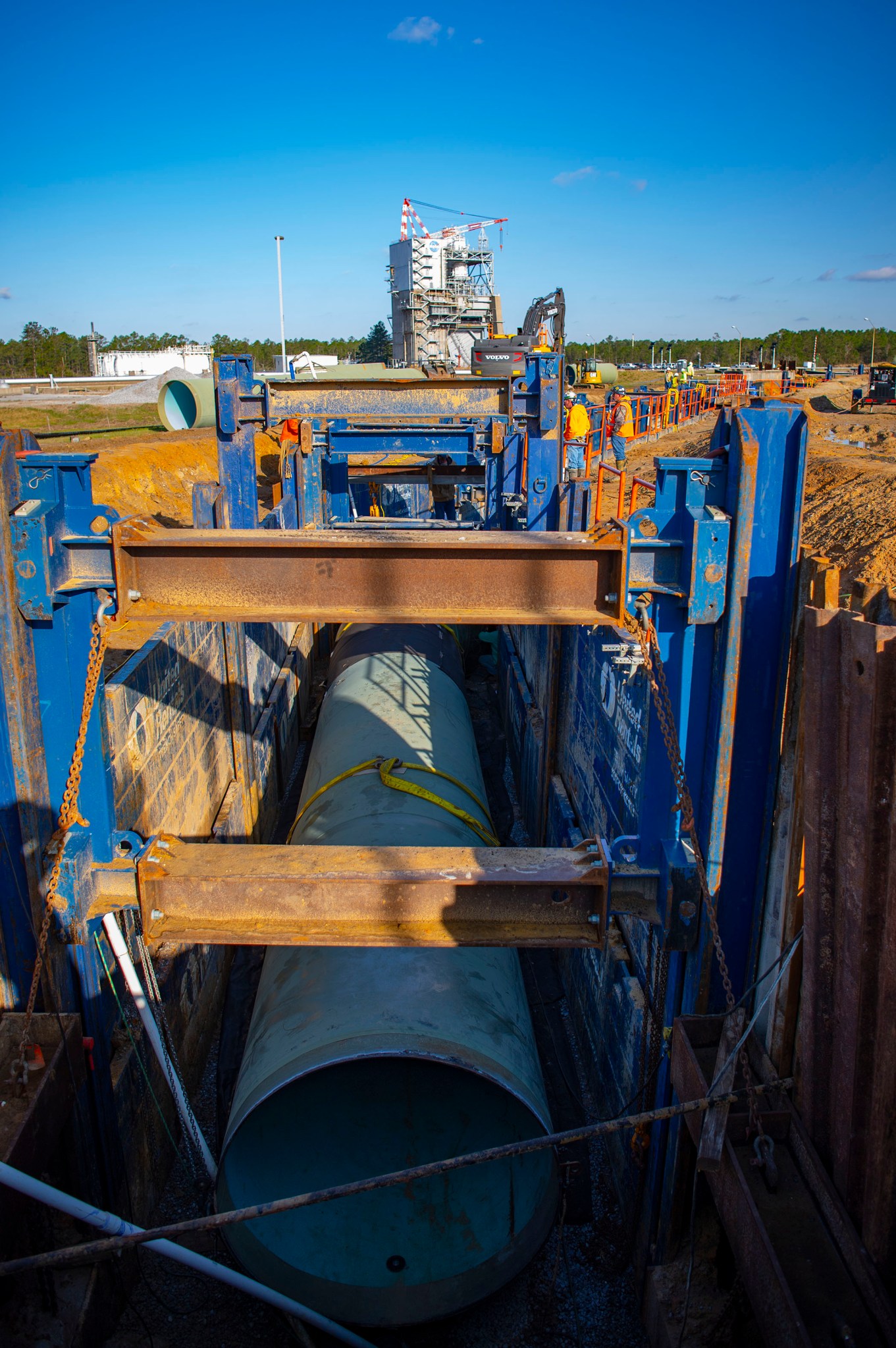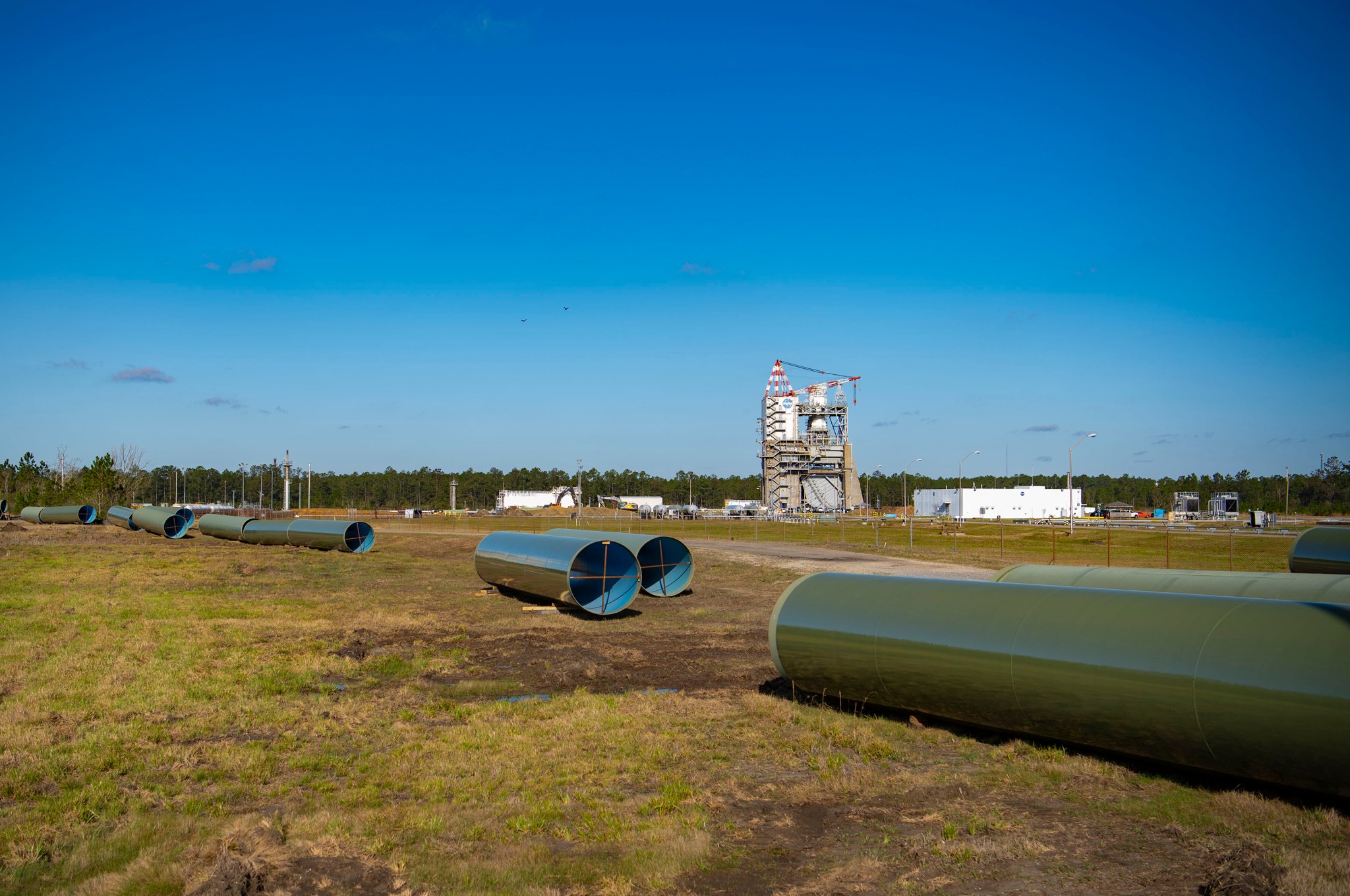
Replacing an average kitchen sink faucet may take an hour with a few common tools. Replacing piping needed to flow 170,000 gallons of water a minute is a different story – and one that demands a clever bit of engineering ingenuity.
Just such a project is underway at NASA’s Stennis Space Center near Bay St. Louis, Mississippi, as crews work to upgrade aging infrastructure by replacing 66-inch piping leading to the historic Fred Haise Test Stand.
“This task is a major undertaking, as there are a number of underground utilities around the Fred Haise Test Stand that we must be careful not to disturb,” said Casey Wheeler, the NASA engineer spearheading the project. “However, it serves a critical need. This is the first time the water pipeline leading to the structure has been upgraded since its original installation.”
A typical single-engine test at Stennis Space Center requires a lot of water – to cool super-hot engine exhaust, reduce test-related noise and vibrations, and use in the event of a facility or propellant barge fire. As much as 1.4 million gallons of water flows to the test stand during a typical eight-and-a-half-minute hot fire. At pressures reaching 225 pounds per square inch, the output is enough to fill about 2,125 standard bathtubs a minute.
The water flows from a 66-million-gallon reservoir at the Stennis High Pressure Industrial Water Facility. Built in the 1960s, maintaining the facility and its related piping is an ongoing challenge.
NASA launched an effort in the mid-2010s to repair and replace system components, including pipes and valves leading to the site’s large test stands. Work at two other large test stands have been completed, with crews now focused on the Fred Haise stand.

Part of the current project involves installing about 2,080 linear feet of new 75-inch piping from the HPIW facility to the valve vault pit serving the test stand. The existing 66-inch piping between these two points will be abandoned in place.
Nearly all of the pipe required for this portion of the project is on site, though four sections still are being fabricated off site. Over 500 feet of the new 75-inch pipe has been laid. The initial stage of this work has involved the use of a shoring system to hold back soil as crews install the piping underground in narrow, vertical pits. The remainder of the installation will shift to a broader, open-pit approach as crews work in a more spacious, cleared forest corridor leading back to the HPIW facility.
A second portion of the project involves approximately 580 feet of existing 66-inch piping running from the valve vault pit to the test stand. This stretch of piping runs adjacent to a complicated network of underground utilities that could be damaged from intensive digging; hence, the engineering challenge.
In response, work crews will forgo digging up the existing piping or even installing new piping. Instead, they will insert a new, 64-inch steel liner inside the older piping, which will reduce project time and cost. Thinking of inserting one drinking straw into another, just slightly larger drinking straw.
“Inserting the new liner requires careful, precise work, with just a two-inch difference in diameter between the liner and the existing piping,” Wheeler said. “We will also be competing against the clock to complete our job within a set timeframe so as to not hold up RS-25 engine testing on the stand.”
This portion of the project will require careful timing, as it will necessitate a service disruption to the test stand’s water supply. Crews will have only 110 days to complete the work in order not to disrupt a busy testing schedule as NASA fires RS-25 engines for its Space Launch System (SLS) rocket on the Fred Haise stand.
Installing the liner requires cutting out a section at the top of the existing pipe and loading in new pieces of rolled steel plating. Crews then will slide the inserted segments into place and weld them together to create a continuous run. Because of the size discrepancy between the existing pipe and the liner, grout will be added into the annular space between them.
While the steel liner will reduce the inside diameter of the water pipe leading from the valve vault pit to the Fred Haise Test Stand, a special interior coating enhancing the new pipe’s smoothness is expected to compensate for the smaller diameter, ensuring no reduction in water flow.
In addition to this engineering feat, crews are slated to install a new 16-inch water line, 460 feet in length, connecting the HPIW piping system to the test stand’s liquid hydrogen barge dock. The new line will provide water in case of a fire involving the highly flammable propellants used for engine testing. The crews also will install a new 12-inch water line running 430 feet from the HPIW system to the test stand’s liquid oxygen barge dock. Similar work is scheduled at the A-2 Test Stand, where large piping already has been upgraded.
“These critical upgrades will enable Stennis Space Center to sustain its rocket propulsion testing capabilities for NASA-led and commercial applications,” Wheeler said. “We look forward to continuing Stennis’ legacy as America’s premier rocket propulsion test site.”
For information about Stennis Space Center, visit:
C. Lacy Thompson
Stennis Space Center, Bay St. Louis, Miss.
228-363-5499
calvin.l.thompson@nasa.gov



























